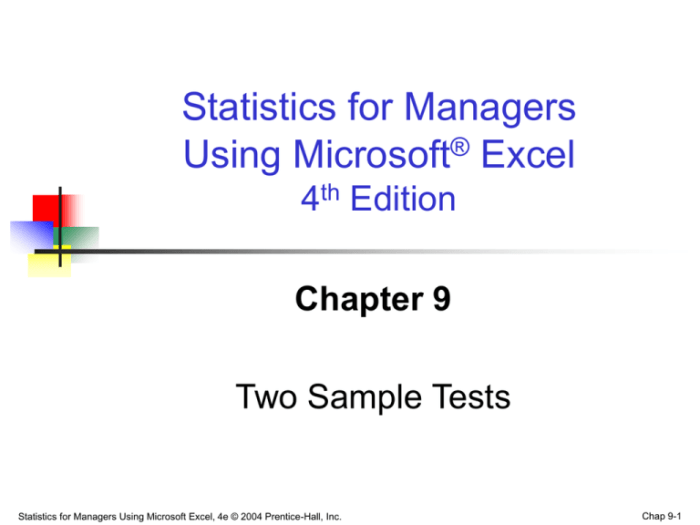Statistics for managers using Microsoft Excel 9th edition empowers business professionals with the knowledge and skills to harness the power of data for informed decision-making. This comprehensive guide provides a structured and accessible approach to statistical analysis, enabling managers to leverage data-driven insights to optimize operations, enhance performance, and drive organizational success.
Through a blend of theoretical foundations and practical applications, this book equips readers with a deep understanding of descriptive and inferential statistics, data visualization techniques, and advanced statistical methods. With a focus on real-world examples and case studies, it demonstrates how statistics can be effectively applied in various management contexts, from marketing and finance to operations and human resources.
1. Introduction
Statistics play a pivotal role in empowering managers with the ability to make informed decisions based on data analysis. In today’s data-driven business environment, it is essential for managers to understand the principles of statistics and how to effectively utilize them.
Benefits of Using Microsoft Excel for Statistical Analysis
- Widely accessible and user-friendly interface
- Comprehensive range of statistical functions and tools
- Robust data handling and manipulation capabilities
- Ability to generate clear and visually appealing data visualizations
2. Getting Started with Microsoft Excel

Excel’s intuitive interface and powerful features make it an ideal platform for statistical analysis. This section provides an overview of the Excel environment, data import and export, and basic data manipulation techniques.
Data Import and Export
- Import data from various sources (e.g., CSV, TXT, databases)
- Export data in different formats (e.g., CSV, XLSX, PDF)
Basic Data Manipulation Techniques
- Sorting and filtering data
- Creating pivot tables and charts
- Performing basic calculations (e.g., sum, average, count)
3. Descriptive Statistics
Descriptive statistics provide a concise summary of a dataset, helping managers understand the central tendencies and variability of the data.
Measures of Central Tendency
- Mean (average)
- Median (middle value)
- Mode (most frequently occurring value)
Measures of Dispersion, Statistics for managers using microsoft excel 9th edition
- Range (difference between maximum and minimum values)
- Variance (average of squared deviations from the mean)
- Standard deviation (square root of variance)
4. Inferential Statistics

Inferential statistics allow managers to make inferences about a population based on a sample. This section covers hypothesis testing and confidence intervals.
Hypothesis Testing
- Null hypothesis (H0) and alternative hypothesis (Ha)
- Significance level (alpha)
- Test statistic and p-value
Confidence Intervals
- Confidence level
- Margin of error
- Interpretation of confidence intervals
5. Data Visualization

Effective data visualization is crucial for communicating insights and trends from statistical analysis. Excel offers a range of charting and graphing options.
Types of Charts and Graphs
- Bar charts
- Line charts
- Scatterplots
- Histograms
Principles of Effective Data Visualization
- Choose the appropriate chart type
- Use clear and concise labels
- Highlight key trends and patterns
FAQ Insights: Statistics For Managers Using Microsoft Excel 9th Edition
What are the key benefits of using Microsoft Excel for statistical analysis?
Microsoft Excel offers several advantages for statistical analysis, including its user-friendly interface, powerful data manipulation capabilities, built-in statistical functions, and ability to create visual representations of data.
What are the different types of descriptive statistics covered in the book?
The book covers various descriptive statistics, including measures of central tendency (mean, median, mode) and measures of dispersion (range, variance, standard deviation).
How does the book help managers apply statistical techniques in real-world scenarios?
The book provides numerous case studies and examples that demonstrate how statistical techniques can be applied to solve practical business problems and improve decision-making.